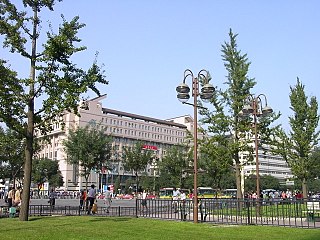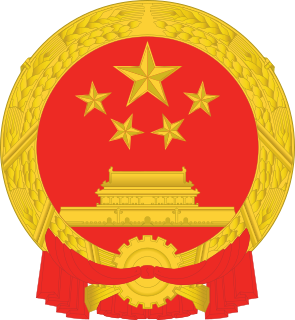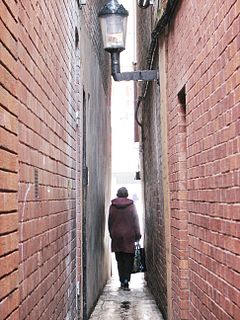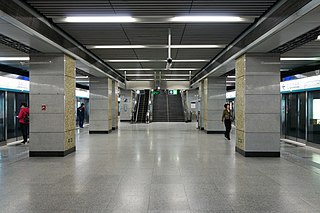
An alley or alleyway is a narrow lane, path, or passageway, often reserved for pedestrians, which usually runs between, behind, or within buildings in the older parts of towns and cities. It is also a rear access or service road, or a path, walk, or avenue in a park or garden.

The Dongcheng District of Beijing covers the eastern half of Beijing's urban core, including all of the eastern half of the Old City inside of the 2nd Ring Road with the northernmost extent crossing into the area within the 3rd Ring Road. Its 40.6 km2 (15.7 sq mi) area is further subdivided into 17 subdistricts.

Xicheng District is a district of Beijing. Xicheng District spans 32 square kilometres (12 sq mi), making it the largest portion of the old city, and has 706,691 inhabitants. Its postal code is 100032. Xicheng is subdivided into 15 subdistricts of the city proper of Beijing. The former Xuanwu District was merged into Xicheng on July 2010.

Beijing Financial Street (BFS), or Beijing Jinrong Street (BJS), is where Chinese regulatory agencies are located. According to 13th 5 years plan, Beijing Financial Street will be positioned more towards a regulatory agencies' precinct. The street is located inside Beijing's innermost 2nd Ring Road.

Andingmen was a gate in Beijing's Ming-era city wall. The gate was torn down along with the city wall in the 1960s. Andingmen is now a place name. Where the gate once stood is now Andingmen Bridge, a roundabout overpass on the northern 2nd Ring Road. The overpass links Andingmen Inner Street which runs south of the overpass inside the walled city and Andingmen Outer Street which runs north away from the wall of the city.

Hutong are a type of narrow street or alley commonly associated with northern Chinese cities, especially Beijing.

The Ministry of Education (MOE) of the People's Republic of China is the agency of the State Council of the People's Republic of China that regulates all aspects of the educational system in mainland China, including compulsory basic education, vocational education, and tertiary education. The MOE certifies teachers, standardizes curriculum and textbooks, establishes standards, and monitors the entire education system in an effort to "modernize China through education". It is headquartered in Xidan, Xicheng District, Beijing. The MOE stresses technical education over other subjects.

Qianmen is the colloquial name for Zhengyangmen, a gate in Beijing's historic city wall. The gate is situated to the south of Tiananmen Square and once guarded the southern entry into the Inner City. Although much of Beijing's city walls were demolished, Zhengyangmen remains an important geographical marker of the city. The city's central north-south axis passes through Zhengyangmen's main gate. It was formerly named Lizhengmen, meaning "beautiful portal".

Parliament Street is a 50-metre (160 ft) long street in the city of Exeter, Devon, England. It links the High Street to Waterbeer Street and dates from the 14th century. At about 0.64 metres at its narrowest and approximately 1.22 metres at its widest, it has been claimed to be the world's narrowest street, although this title actually belongs to the Spreuerhofstraße in Reutlingen, Germany.

Lingjing Hutong Station is a station on Line 4 of the Beijing Subway, located on Xidan North St., about 150 m (490 ft) north of the west entrance of Lingjing hutong, after which it is named.

Lusongyuan Hotel is a 3-star traditional courtyard hotel in Beijing, China. The Hotel lies in the central district of Beijing, in an old-styled Hutong in the eastern part of the city. It is surrounded by many historical buildings built from the Yuan, Ming and Qing dynasties that are still preserved today. Hutongs and quadrangles are typical Beijing architectural structures featured here. Hutongs are ancient styled lanes unique to Beijing. Quadrangles are the main structures inside hutongs.

Spreuerhofstraße is, according to Guinness World Records, the world's narrowest street, found in the city of Reutlingen, Germany. It ranges from 31 centimetres (12.2 in) at its narrowest to 50 centimetres (19.7 in) at its widest. The lane was built in 1727 during the reconstruction efforts after the area was destroyed in the massive citywide fire of 1726 and is officially listed in the Land-Registry Office as City Street Number 77.

Dashilan(simplified Chinese: 大栅栏; traditional Chinese: 大柵欄; pinyin: Dàshilànr) is a subdistrict of Xicheng District, in Beijing, China.

Lingjing hutong is a hutong in Beijing, located near to Xidan, in the Xicheng district. It is approximately 600 metres (2,000 ft) long, running from Xidan North St. to Fuyou St. With a width of 32 metres (105 ft), it is considered the broadest hutong in Beijing.
Money market may refer to:

Shanghai–Nantong railway, abbreviated as Hutong railway is a future railway in China's Yangtze River Delta area. It will connect the region's main city, Shanghai, located south of the Yangtze, with Nantong, north of the river.

Hutong School is a foreign-owned Mandarin-language teaching school and internship provider in China that was founded in March 2005 by a group of French, German, Korean, Flemish, and Chinese entrepreneurs. It is the first Chinese-language school under foreign management officially licensed by the Chinese Ministry of Education. It provides Chinese-language courses and matches students with internships in China and has had over 8,000 students.


















